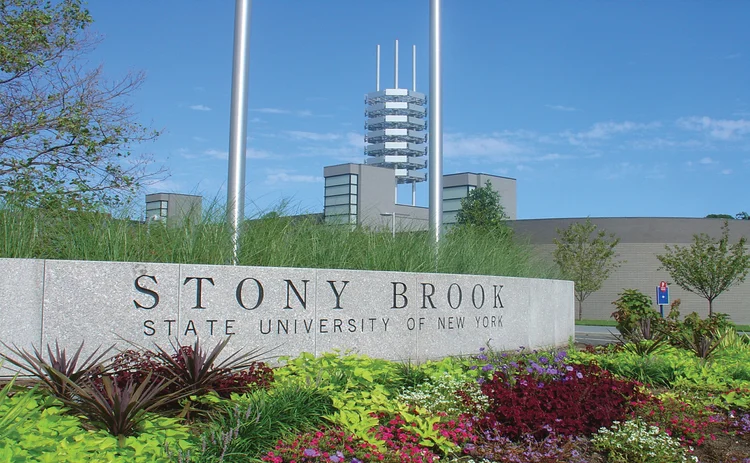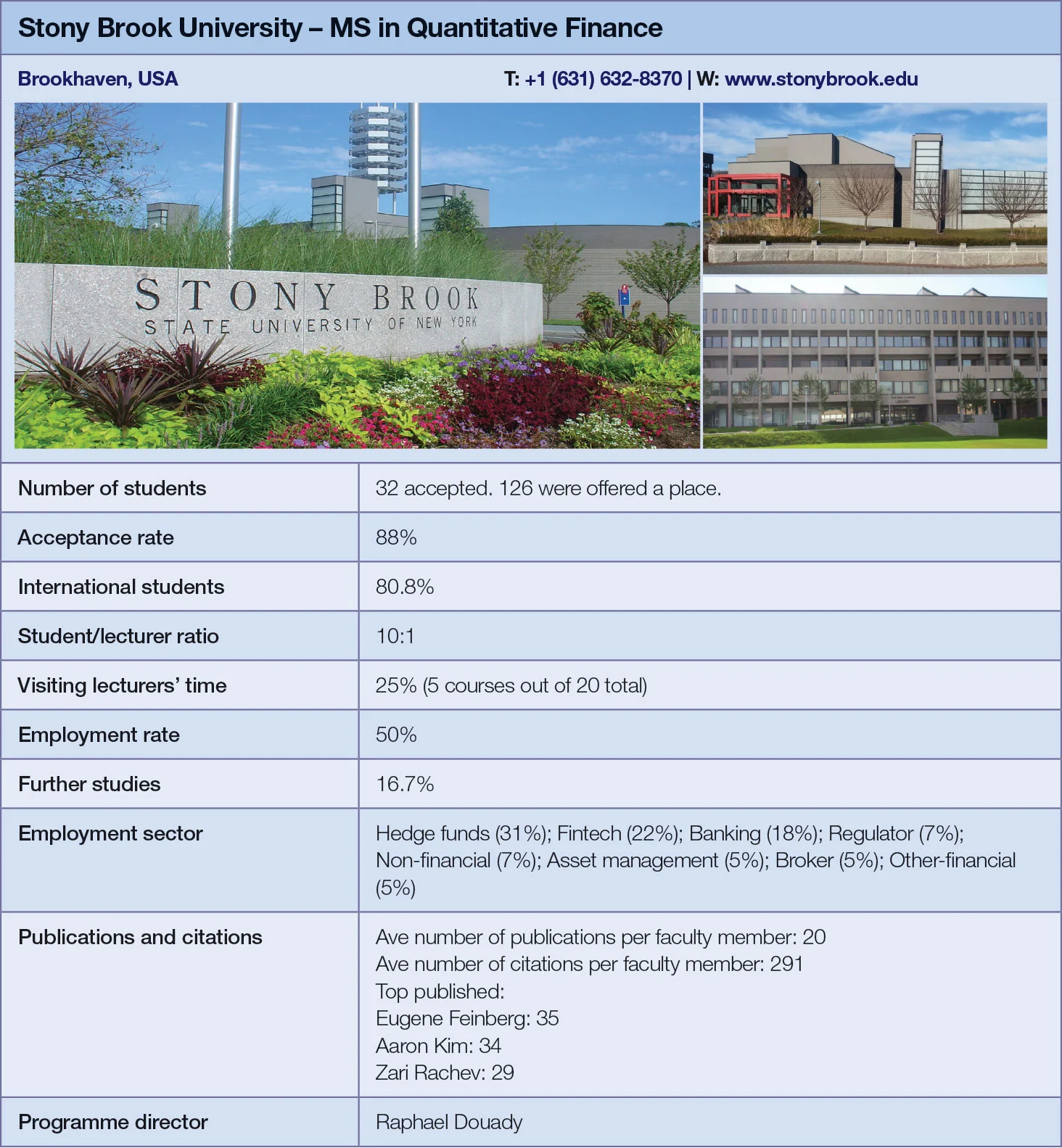
Quant Guide 2017: Stony Brook University
Brookhaven, USA

MS in Quantitative Finance | metrics table at end of article
In 2004, Robert Frey – managing director of hedge fund manager Renaissance Technologies and a legendary figure in the quant community – decided to call time on his illustrious trading career. Rather than enjoy a comfortable retirement, however, Frey set about addressing what he perceived to be a long-standing problem in academia: a lack of dedicated applied mathematics programmes tailored to the theory and practice of finance.
“There were essentially finance programmes that tried to take financial analysts and enhance their math skills,” recalls Frey, who founded the programme. “I had been at Renaissance for 14 years, and it was time to monetise the time I had invested there. I am an alumnus of Stony Brook, so I decided to go with them.”
The programme was designed to produce applied mathematicians whose area of practice was finance. The financial crisis threw into sharp relief the need for quants to have a stronger mathematical foundation, says Frey: huge losses on credit derivatives portfolios suffered between 2007 and 2009 – widely blamed for sparking the crisis – are often attributed to a lack of understanding of the applicability of Gaussian pricing models to credit products.
“In 2008, you had a proliferation of insane practices, where you had those crazy exotic products, and it was clear to anyone who understood math that the tools people were using to evaluate these were developed in a different context,” says Frey. “The people doing this didn’t understand the math behind the formula. Mechanically applying valuation techniques – that’s really the problem. If you want to hire someone to do portfolio optimisation or price an option, you really want to make sure that person understands the mathematics and how it links with the underlying economic concepts,” he adds.
One of Stony Brook’s cited strengths is its teaching staff’s depth of industry experience. Aside from Frey – who before joining Renaissance worked for Morgan Stanley in one of the first dedicated quant trading groups in the 1980s – it employs Raphael Douady, the programme’s chair. Douady co-founded Riskdata, which provides buy-side firms with risk management software.

“I chose this programme because of the faculty: most of them have extensive experience in using quantitative trading systems,” says Siqi Fan, who graduated from the programme in 2017, and is currently interning with the corporate risk team at JP Morgan. “In class, they don’t just teach us from text books, but use practical examples. The career service is another reason: we have very supportive academic advisers such as Douady, who have a very strong relationship with people in academia and the industry. They provide a lot of opportunities for us.”
The small class size of around 30 people is cited as another of Stony Brook’s strong suits. In terms of student admissions, the programme seeks to imitate the Renaissance recruitment model, says Douady: “I’d rather have a student who studied engineering, maths, physics and doesn’t have a clue about finance. Someone who did an undergraduate degree in finance or economics will never catch up with them – it’s too high-level for them.”
Perhaps unsurprisingly, a sizeable proportion of graduates end up in hedge funds.
All students are required to take the same foundation course on financial mathematics. Then, they can choose between four different tracks: buy-side (portfolio analytics, intraday frequency analytics, data analysis and statistics); asset and derivatives pricing; hedge funds; or big data.
Regardless of the track chosen, all students must complete eight mandatory courses and a set of electives. As a result, they will all know the basics of option pricing, portfolio allocation and statistical time series analysis.
Students can also benefit from extra-curricular activities; for example, there is a weekly event called ‘Pizza with professors’. During these sessions, professors give a presentation on an area of their research, providing students with an opportunity to ask questions and engage in debates.

Click here for links to the other universities and an explanation of how to read the metrics tables
Only users who have a paid subscription or are part of a corporate subscription are able to print or copy content.
To access these options, along with all other subscription benefits, please contact info@risk.net or view our subscription options here: http://subscriptions.risk.net/subscribe
You are currently unable to print this content. Please contact info@risk.net to find out more.
You are currently unable to copy this content. Please contact info@risk.net to find out more.
Copyright Infopro Digital Limited. All rights reserved.
As outlined in our terms and conditions, https://www.infopro-digital.com/terms-and-conditions/subscriptions/ (point 2.4), printing is limited to a single copy.
If you would like to purchase additional rights please email info@risk.net
Copyright Infopro Digital Limited. All rights reserved.
You may share this content using our article tools. As outlined in our terms and conditions, https://www.infopro-digital.com/terms-and-conditions/subscriptions/ (clause 2.4), an Authorised User may only make one copy of the materials for their own personal use. You must also comply with the restrictions in clause 2.5.
If you would like to purchase additional rights please email info@risk.net
More on Quantitative finance
Quant Finance Master’s Guide 2026
Risk.net’s guide to the world’s leading quant master’s programmes, with the top 25 schools ranked
Baruch, Princeton cement duopoly in 2026 Quant Master’s Guide
Columbia jumps to third place, ETH-UZH tops European rivals
Quant Finance Master’s Guide 2025
Risk.net’s guide to the world’s leading quant master’s programmes, with the top 25 schools ranked
Baruch maintains top spot in 2025 Quant Master’s Guide
Sorbonne reclaims top spot among European schools, even as US salaries decouple
Quant Finance Master’s Guide 2023
Risk.net’s guide to the world’s leading quant master’s programmes, with the top 25 schools ranked
Baruch topples Princeton in Risk.net’s quant master’s rankings
US schools cement top five dominance as graduate salaries soar
Is it worth doing a quant master’s degree?
UBS’s Gordon Lee – veteran quant and grad student supervisor – asks the hard question
Starting salaries jump for top quant grads
Quant Guide 2022: Goldman’s move to pay postgrads more is pushing up incomes, says programme director







